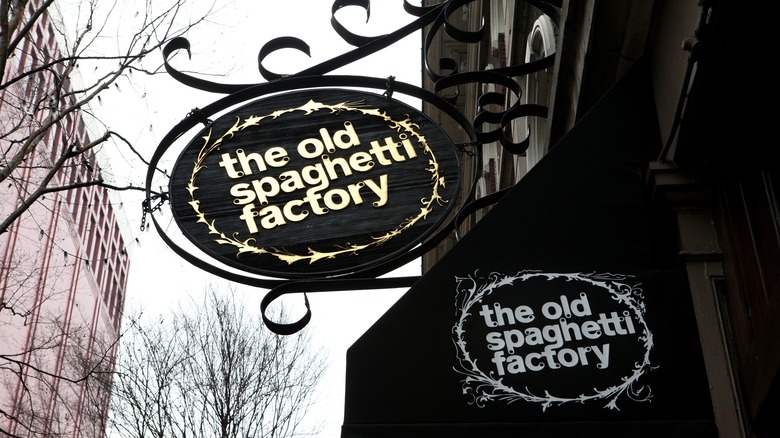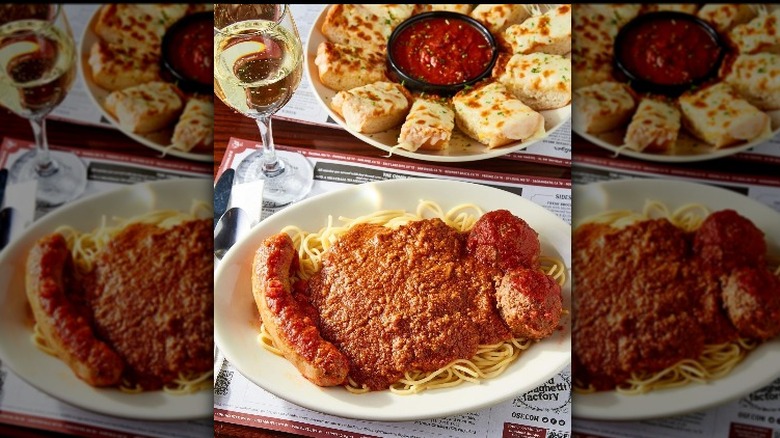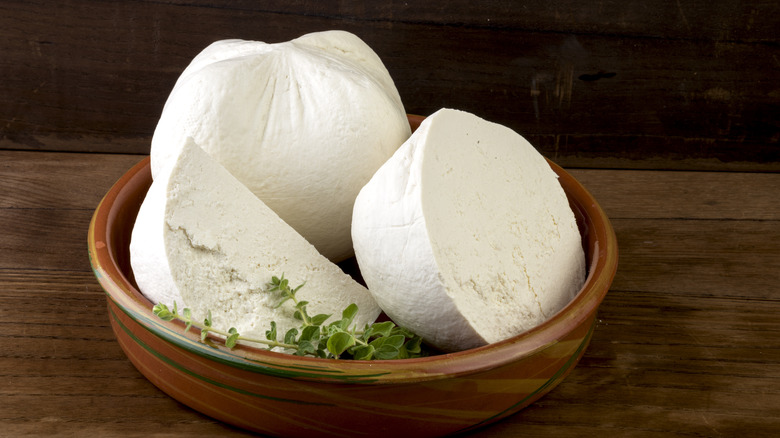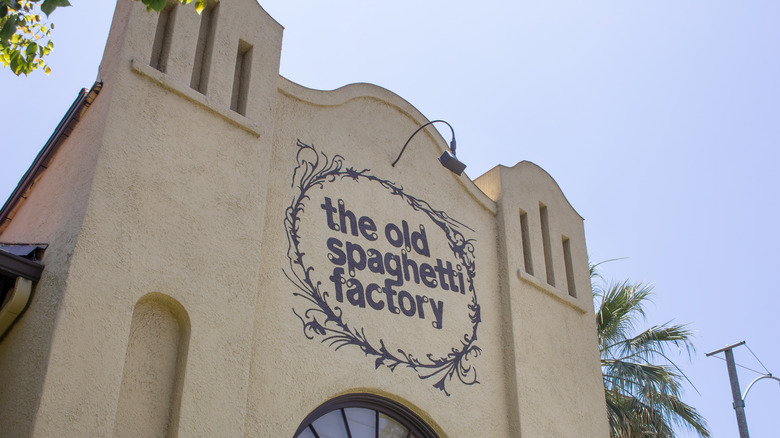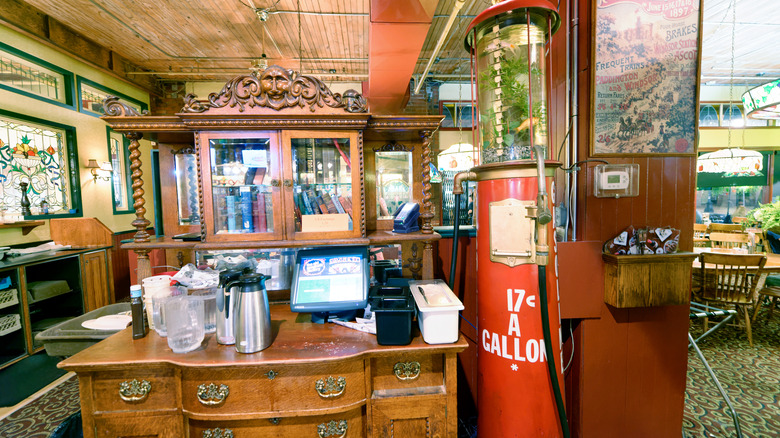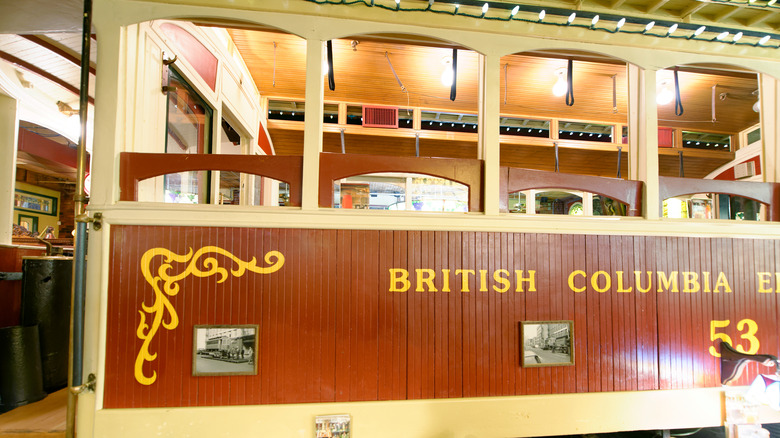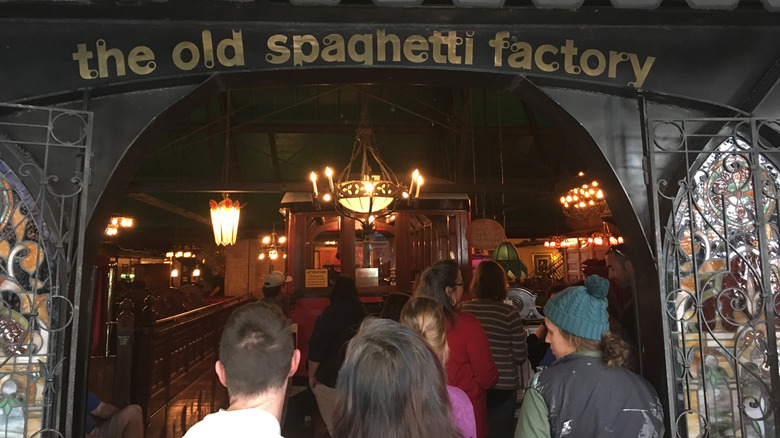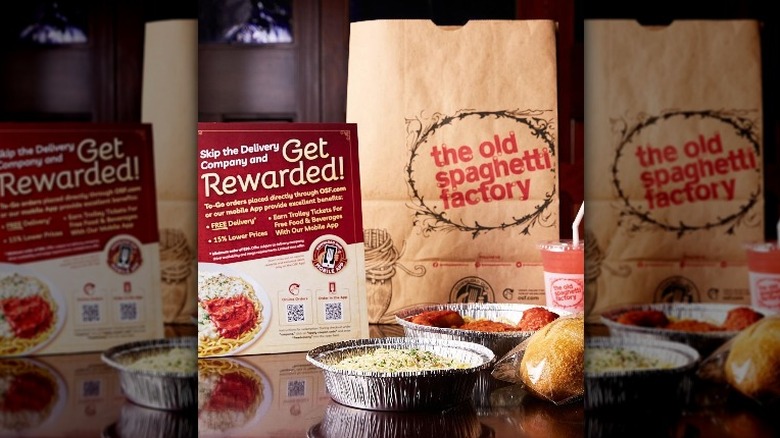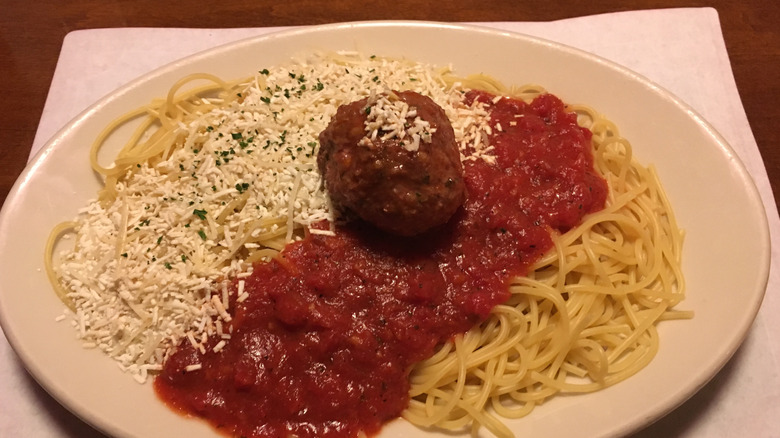The Old Spaghetti Factory: 11 Facts About The Restaurant
When Guss and Sally Dussin opened the first Old Spaghetti Factory in Portland, Oregon, in 1969, their goals were simple: To offer comforting, affordable meals in a welcoming, family-friendly setting. A second-generation restaurateur, Guss Dussin understood the financial and logistical challenges of running a restaurant and decided to focus on pasta, a relatively inexpensive food he knew would be popular with a wide range of diners.
The restaurant's early moments didn't augur well, however. Their first night of business — January 10, 1969 — yielded total receipts of $171.80 (per Funding Universe), a paltry sum even for that time, and family friends worried about the fate of the fledgling business. Fortunately, their concerns were soon allayed. By the end of the restaurant's first year, the Dussins had served over 200,000 meals and earned $400,000 in revenue. This success gave them the confidence to open two more restaurants, which became the start of an enduring and much-loved national brand.
The Old Spaghetti Factory remains a family-owned business
Because of its high profile and international reach (besides its U.S. restaurants, the Old Spaghetti Factory has franchises in Japan), it's easy to assume the chain is just another anonymous corporate entity. But nothing can be further from the truth — since its opening, the Old Spaghetti Factory has remained a family-owned-and-operated business.
Founders Guss and Sally Dussin ran the fledgling chain in its early years and, like many owners of family businesses, recruited their kids to help. "I think I was 14 when I first started bussing tables," their son, Chris Dussin, told FSR Magazine. "From when I was a teenager, my dad would always be talking to me about, 'well you're going to be in the company and someday you'll run the business,' so he always planted the seed. Let's put it that way." But like many teenagers, he balked at the prospect of following so closely in his parent's footsteps — but eventually, the appeal of the business won him over: He served as president of the company from 1997 to 2015, when he handed the reins over to his brother-in-law but remained chairman of the company.
Its most popular dish almost didn't make it onto the menu
Walk into almost any family-friendly Italian-American restaurant, and you can predict what will be on the menu — spaghetti and meatballs, garlic bread, a chicken dish or two. But a favorite item among fans of the Old Spaghetti Factory is one you're unlikely to see on other menus — spaghetti with mizithra cheese and browned butter. (Mizithra cheese is a traditional Greek cheese made from the whey of sheep or goat's milk, per Cheese.com.)
So how did a dish with a distinctively Greek ingredient end up on the menu of an Italian-inspired restaurant? The answer is legal bureaucracy. According to the company's webpage, Old Spaghetti Factory founder Guss Dussin ran into a roadblock when trying to open his first Old Spaghetti Factory restaurant: His proposed menu was too short. By law, he needed one more item on the menu to qualify for a liquor license. Wracking his brain for another item consistent with the rest of his menu — something appealing as well as family and budget-friendly — he added an old family recipe for spaghetti with browned butter and mizithra cheese. This new menu item not only allowed him to secure a license but made an obscure family favorite into one of the restaurant's iconic dishes.
The restaurant chooses unusual locations for a reason
Unlike most popular chain restaurants, which tend to move into the newest shopping centers or build their own restaurants, the many branches of the Old Spaghetti Factory tend to be located in pre-existing buildings, many of which are old factories or warehouses. For instance, per Fox 26 News, the Fresno branch was located in an old raisin-packing plant.
This unconventional tactic is about much more than visual branding. Per the South Waterfront Blog, Old Spaghetti Factory founder Guss Dussin deliberately gravitated towards inexpensive properties in old warehouse districts, offering distinctive touches such as exposed bricks and vintage woodwork, along with ample space for high-volume restaurants at affordable prices (via Funding Universe). Successful restaurants in these overlooked locations, Dussin believed (per the South Waterfront Blog), would attract other businesses and more visitors to the area — which would mean more foot traffic to his restaurants.
The restaurant's distinctive décor is consistent across locations
While each Old Spaghetti Factory location has a unique historical setting and layout, you'll see the same quirky style of décor in each — stained glass, booths framed by brass headboards, and lots of velvet, along with plenty of vintage (or vintage replica) lamps and decorative items. So no matter where you visit, you'll feel a bit like you've walked into a large, high-energy antique shop.
This distinctive look has been a part of the Old Spaghetti Factory since its beginning. Per FRS Magazine, co-founder Sally Dussin devised the look (partly because of the low cost of garage-sale antiques) and continued to contribute to the design of the restaurants over the years. "Mom and Dad had a deal — he took care of the food and kitchen side of the restaurants and she handled the design," Chris Dussin, the son of founders Guss and Sally Dussin, told FRS magazine. And for the Old Spaghetti Factory, interior design is not just an afterthought: According to Funding Universe, the company has a 25,000-square-foot warehouse and a dedicated team of craftspeople to collect and restore antiques for the restaurants.
Here's why there's a trolley inside every restaurant
Another distinctive feature of the décor at each branch of The Old Spaghetti Factory has nothing to do with pasta or factories: Inside each is an old trolley, hollowed out and refurbished for use as a seating area. This is another unique quirk that has been part of the restaurant since its founding: Per Westword, co-founder Sally Dussin was out hunting for antiques to decorate the first restaurant when she spotted an abandoned trolley in a field. Thinking it would fit perfectly with the vintage theme she'd envisioned, she had it brought back to the restaurant and retrofitted as a seating area. And according to the company's website, the trolley became such a central part of the restaurant's décor that when the original Portland, Oregon, location relocated, the trolley moved to the new location too.
Since then, trolleys have become a signature part of the restaurant's décor. But according to FSR Magazine, because vintage trolleys can pose accessibility challenges, many of the trolleys now in use are replicas made especially for the restaurant.
The restaurant's co-founder worked at the restaurant into her 90s
For the Dussin family, The Old Spaghetti Factory began as a pragmatic means of supporting the family but grew into a labor of love. "Dad started that 50 years ago, that if you treat people well, they're going to treat the guests well and that's really why we are here," Chris Dussin, son of co-founders Guss and Sally Dussin, told the Portland Business Journal.
Key to the restaurant's success was co-founder Sally Dussin, who created the restaurant's signature look. But her work didn't stop with the completion of the original restaurant. Instead (per Fox 26 News), she remained active in helping design the interiors of new locations, making regular appearances at their flagship restaurant in Portland, Oregon, until her death at age 92 in 2021. "Sally found great joy and purpose in building, decorating and opening new OSF locations," Dean Griffith, president of The Old Spaghetti Factory, told Fox 26 News following her death. "She greatly loved spending time with team members, managers, corporate office and Design Shop staff. She will be dearly missed."
A few smart strategies help the restaurant keep food costs low
Per Westword, The Old Spaghetti Factory has long been a popular spot for family meals and big parties — not only does it offer kid-friendly comfort food in a festive atmosphere, but it does so affordably. The Old Spaghetti Factory has continued to thrive despite its somewhat old-fashioned menu, even in cities filled with flashier cutting-edge restaurants (via Portland Business Journal). "Most of what's happening in Portland is more small restaurant and chef-driven," company chair Chris Dussin told the Portland Business Journal. "It's not as conducive to family dining. We are competing more with all of the chains that do family dining. And because our price point is much more competitive than the chains, we have the advantage."
A few key strategies have helped The Old Spaghetti Factory keep food quality high and costs low. One strategy, per FSR Magazine, is a small, carefully selected choice of menu items. Besides having flavorful dishes a wide range of diners would enjoy, they had to be easily made in bulk and quickly prepared for service. (Over the years, a few dishes found to slow down service were dropped from the menu.) In addition, per Funding Universe, employees at The Old Spaghetti Factory are trained to minimize food waste, keeping overhead low and prices down.
The restaurant has a fraught history with franchising
The success of The Old Spaghetti Factory has attracted the attention of investors wanting to either buy the company outright (per the Portland Business Journal) or open franchises (per FSR Magazine). But the family-owned company has never seriously considered selling the business, considering the quality of its growth more important than the speed.
The restaurant has also been cautious about franchising requests. As the Portland Business Journal reports, in 1971, founder Guss Dussin was approached by a Texas investor wanting to buy a franchise of The Old Spaghetti Factory. When Dussin turned down the request, the investor simply replicated the restaurant under a different name, down to its signature indoor trolley. And while some franchises were granted to Dussin family members in the 1990s (per Funding Universe), and the restaurant has long had a partnership with franchisees running the two Old Spaghetti Factory restaurants in Japan, the company has opted not to actively court franchisees. "You've got to have somebody who's going to follow your recipes and not want to change things," company chair Chris Dussin told FSR Magazine in 2019. "It's one more thing to worry about."
Cultivating customer loyalty is a priority for the restaurant
One reason for the longevity of The Old Spaghetti Factory is its focus on cultivating customer loyalty: Its goal has always been not just to bring diners in, but to keep them coming back. And an important strategy for the restaurant has been its incentive program: By signing up for The Old Spaghetti Factory's rewards program, diners can earn points towards free food, special offers, and other goodies by dining at the restaurant.
But the restaurant also leverages its unique company culture to build relationships with its diners. The restaurant builds goodwill by cultivating a welcoming atmosphere for families, which translates into return visits and multigenerational loyalty. "We've always been able to do big groups well, families and kids," company chair Chris Dussin told the Portland Business Journal. "You build that kind of memory bank business. You can't place a number on it. It just becomes part of the fabric of people's upbringing and what they remember as a kid."
Here's what you can expect with your meal
Cynical diners sometimes assume that all chain restaurant food is fake, pre-made in a factory, and shipped off to the restaurant's far-flung outlets to be reheated and served. And let's face it, a national chain with the word "factory" in its name doesn't exactly scream handcrafted cuisine. But contrary to what you might think, per Handshake, each Old Spaghetti Factory location prepares the chain's recipes from scratch on-site using primarily fresh ingredients.
Diners at The Old Spaghetti Factory can not only expect freshly made meals but hearty ones. Per the restaurant's website, all entrees are presented as three-course meals — along with your entrée; you will get a hot loaf of bread, soup, or salad, as well as a scoop of ice cream (vanilla or spumoni) for dessert. So how will your meal taste? Per Westword, it's pretty much what you'd expect — wholesome but a bit on the timid side. For instance, the heat level in Spaghetti Vesuvius, advertised on the menu as "spaghetti with a KICK!" thanks to Tabasco sauce and cayenne, was barely perceptible. But according to a restaurant executive interviewed by Westword, the light hand with seasonings is intentional — the food is meant to appeal to everyone, not just hardcore foodies. So if you're craving familiar comfort food or are looking for a restaurant with a pleasant atmosphere that will also appeal to your kids, The Old Spaghetti Factory could be just what you need.
Family and community are a big part of the restaurant's culture
As a family-owned restaurant, The Old Spaghetti Factory has always made families and community an important part of its company culture. Even its unusual practice of locating its restaurants in old warehouses and other overlooked historic buildings is meant to be a way of cultivating lasting bonds with local communities. "People in the community wherever we've gone and done that love that they feel like we've kind of reclaimed their history, and the Spaghetti Factory is part of it now," company chair Chris Dussin told FSR Magazine.
The restaurant also has other programs in place to support the communities where its restaurants are located. Through its Let's Eat Out fundraising programs for local organizations and charities, the restaurant contributes 10% of pre-tax sales (from online purchases or onsite dining) from participating diners to their organization. To support kids and education, the restaurant also runs a Reading Rewards program, in which each participating child who reads five books earns a free child's meal.
